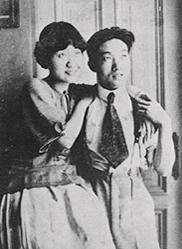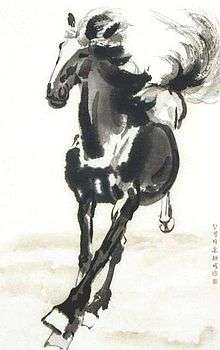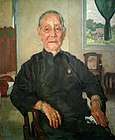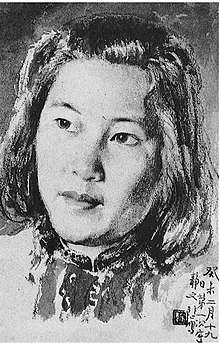Xu Beihong
Xu Beihong (Chinese: 徐悲鴻; Wade–Giles: Hsü Pei-hung; 19 July 1895 – 26 September 1953), also known as Ju Péon, was a Chinese painter.[1]
Xu Beihong | |||||||||
|---|---|---|---|---|---|---|---|---|---|
徐悲鴻 | |||||||||
 | |||||||||
| Born | 19 July 1895 | ||||||||
| Died | 26 September 1953 (aged 58) Beijing | ||||||||
| Nationality | Chinese | ||||||||
| Other names | Ju Péon | ||||||||
| Known for | Oil painting, Chinese ink painting | ||||||||
| Chinese name | |||||||||
| Traditional Chinese | 徐悲鴻 | ||||||||
| Simplified Chinese | 徐悲鸿 | ||||||||
| |||||||||
He was primarily known for his Chinese ink paintings of horses and birds and was one of the first Chinese artists to articulate the need for artistic expressions that reflected a modern China at the beginning of the 20th century. He was also regarded as one of the first to create monumental oil paintings with epic Chinese themes – a show of his high proficiency in an essential Western art technique.[2] He was one of the four pioneers of Chinese modern art who earned the title of "The Four Great Academy Presidents".[3]
Biography
Xu was born on 19 July 1895 in Yixing, Jiangsu, during the late Qing dynasty. It is imperative to note that he began studying classic Chinese works and calligraphy with his father Xu Dazhang who was a private school teacher[1] at the age of six, and Chinese painting at the age of nine. Beihong came from rural Yixing, Jiangsu province. He started from the scratch and in the end became a well-known figure in the world due to his contributions in the art industry.[1]
In 1915, he moved to Shanghai, where he made a living off commercial and private work. In 1916, Xu got in Fudan University to learn French. He then traveled to Tokyo in 1917 to study arts. When he returned to China, he began to teach at Peking University's Arts school at the invitation of Cai Yuanpei. Xu won a scholarship at the prestigious National High School of Art in Paris in the year 1919. He studied and travelled in Europe in more than a decade and was mainly inspired by Classic traditions of European art and culture, which helped him in incorporating improved creativity and innovation elements in his artwork.
Beginning in 1919, Xu studied overseas in Paris at the École Nationale Supérieure des Beaux-Arts, where he studied oil painting and drawing. He was known as Ju Peon while studying in Paris.[4] His painting has been showcased in various platforms and used by learner in understanding what transpired during the early period in relation to Chinese art industry.[1]
His travels around Western Europe allowed him to observe and learn Western art techniques. Xu Beihong still wrote regularly for the Daily University of Peking University that dealt with wider issues then just campus politics. Xu addressed issues of Art and Art History and in 1920 a university art journal called Painting Miscellany was published.[5]

He and his partner Jiang Biwei came back to China in 1927 and, from 1927 to 1929, he gained a number of posts at institutions in China, including teaching at National Central University (now Nanjing University) in the former capital city Nanjing.
In 1933, Xu organized an exhibition of modern Chinese painting that traveled to France, Germany, Belgium, Italy, and the Soviet Union.He studied and travelled in Europe in more than a decade and was mainly inspired by Classic traditions of European art and culture, which helped him in incorporating improved creativity and innovation elements in his artwork.Through Xu’s art work, the western world have had an opportunity to experience and understand Chinese culture, which was found to be interesting.[1]
During World War II, Xu traveled to Southeast Asia, holding exhibitions in Singapore and India. All the proceeds from these exhibitions went to Chinese people who were suffering as a result of the war.

After the founding of the People's Republic of China in 1949, Xu became president of the Central Academy of Fine Arts and chairman of the China Artists Association. Xu Beihong was a master of both oils and Chinese ink. Most of his works, however, were in the Chinese traditional style. Xu beihong had a free technique of brush in his art works; he also believed that painting should be more real and should be more understood by people.[6]
In his efforts to create a new form of national art, he combined Chinese brush and ink techniques with Western perspective and methods of composition. He integrated firm and bold brush strokes with the precise delineation of form. As an art teacher, he advocated the subordination of technique to artistic conception and emphasizes the importance of the artist's experiences in life. Of all of the Painters of the modern era, it can be safely said that Xu is the one painter most responsible for the direction taken in the modern Chinese Art world. In the painting of Beihong in 1949 and the specific influence such has in the art as well as politics. It is evident that Xu’s art was aimed at creating a picture to the viewers to understand various events occurring in China. Nonetheless, Xu’s work could also be used in understanding not only social but also political events specifically in the New China.
The policies enacted by Xu at the beginning of the Communist Era continue to control not only official Government Policy towards the arts, but they continue to direct the overall direction taken in the various Art Colleges and Universities throughout China.[7]
Xu enjoyed massive support from art collectors across Asia. Between 1939 and 1941, he held solo exhibitions in Singapore, India and Malaya (Penang, Kuala Lumpur and Ipoh) to help raise funds for the war relief effort in China. In one war benefit exhibition in March 1939, Xu held a group exhibition with Chinese ink painting masters Ren Bonian and Qi Baishi, and showcased 171 works of art at the Victoria Memorial Hall.[8]
He also met luminaries such as Rabindranath Tagore and Mahatma Gandhi during his stay in India, and got his sources of inspiration which led to the creation of iconic works such as the 4.21m-wide The Foolish Old Man Who Removed the Mountains painting on show at the Singapore Art Museum (SAM). Artworks like After a Poem of the Six Dynasties, Portrait of Ms Jenny and Put Down Your Whip were also created during his sojourns in Southeast Asia. SAM Director Kwok Kian Chow mentioned that Xu's name tops the list in Asian modern realism art, and his connections with various parts of Asia and Europe opened a new chapter of historical narratives, exchanges and influences of aesthetics and ideas in art.[2]
Xu constantly pushed the boundaries of visual art with new techniques and international aesthetics, in bid to reinvent Chinese art. In fact, Xu's influence extends beyond China in the early 20th-century. Many pioneer Singapore artists such as Chen Wen Hsi, Lee Man Fong and Chen Chong Swee looked up to him as a mentor and a worthy peer, sharing Xu's advocate to closely observe nature and inject realism into Chinese painting.[9]
Xu died of a stroke in 1953. After his death, a Xu Beihong Memorial Museum was established at his home in Beijing by his wife Liao Jingwen.
Family Feud
In 2008, two ceramic vases created by Xu Beihong scheduled for an art exhibition in Singapore spurred local media attention. Family disputes broke out over the vases sales and profits, which led to legal tussles between the Huang descendants and the Singapore Art Museum. The Singaporean art collectors, Huang Man Shi and Huang Meng Gui, were famously supportive of Xu Beihong. The 18-cm high vases were made in the 1940s, titled Malay Dancers and Orchid were to be shown in a Jack Bonn curated exhibition in collaboration with the Singapore Art Museum, "Xu Beihong in Nanyang", as an attribution to the late grandfather and granduncle for the periods when Xu was a guest at his grandfather's estate. These items were returned as certain family members' feud led to the eventual auction failure and cancellation. The Museum maintained they were unaware of the legal implications surrounding the artifacts. Members of the Huang family adheres to the artifacts returning to the "original owners", in 2009.[10]
Controversy
Xu's son, Xu Boyang, signed an affidavit that a nude portrait that had been found was of his mother Jiang Biwei. The painting was then sold for approximately $11m in 2010 at Beijing Jiuge Auctions. After the sale it was claimed that the painting was not by Xu Beihong but it was a piece created in 1983 by a student at the Central Academy of Fine Arts.[11]
Gallery

 Portrait of Ms Jenny (1939)
Portrait of Ms Jenny (1939)
Size: unknown
Medium: Oil on canvas
A Cantonese dance hostess from Singapore commissioned by the then-vice-consul of Belgium to Singapore. Portrait Of Young Lady (1940)
Portrait Of Young Lady (1940)
Size: 82 x 54 cm
Medium: Oil on canvas
This portrait, completed in JiangXia Tang (江夏堂) in Singapore, was of Christina Li HuiWang, who became the first wife of Asian mogul Loke Wan Tho. Portrait of Madam Cheng (1941)
Portrait of Madam Cheng (1941)
Size: 79.5 x 65 cm
Medium: Oil on board
Painted by Xu in Ipoh, when Cheng was 92 who was the mother of Cheong Chee (1885-1954), a wealthy Chinese tin miner and philanthropist in Malaya. Liao Jingwen (1943)
Liao Jingwen (1943)
Size:unknown
Medium: Ink on paper
Painting of Liao Jingwen finished in 1943 when Liao had just begun working for Xu at the China Academy of Art.
Personal life
Xu Beihong went to Japan to study arts in 1917. Jiang Biwei, who was already engaged to another man, went with him to Japan without the consent of her family. Her family said that she had died to cover their embarrassment.[12] In 1927, Xu Beihong and Jiang Biwei had a son and a daughter. Three years later, Xu Beihong had a love affair with his student Sun Duoci.[13] The affair ended with Jiang Biwei's intervention, but the damage to their marriage was done.[13] This account is questioned in a biography written by Xu Beihong's later wife - Liao Jingwen states that there was no improper relationship between Xu Beihong and the student. It goes on to describe how Jiang Biwei was having an affair herself with the married official Zhang Daofan. It was Zhang who suggested Xu had been having an improper relationship in order to further drive a wedge between the couple.[14] However, finally their 20-year painful relationship ended with a divorce in 1945. In 1946, Xu Beihong married Liao Jingwen, a librarian who took care of his life and career until he died in 1953. They had a son and a daughter.[15]
Other media
A 24-episode historic television series depicting Xu's life from early adulthood until 1949 was produced in Hebei and aired in Chinese television in 2013.
References
- 毕楠. "Five major works of Xu Beihong that shouldn't be missed - Chinadaily.com.cn". China Daily. Retrieved 2019-11-20.
- "Singapore Art Museum (SAM) opens 'Xu Beihong in Nanyang' a Solo Exhibition". Art Knowledge News. Retrieved 2008-06-18. Cite journal requires
|journal=(help) - "PROPERTY FROM AN IMPORTANT PRIVATE ASIAN COLLECTION-Yan Wenliang".
- Dillon, Michael, ed. (1998). China: A Cultural and Historical Dictionary. London: Curzon Press. pp. 359. ISBN 0-7007-0439-6.
- Brown, edited by Rebecca M.; Hutton, Deborah S. (2011). A Companion to Asian Art and Architecture. Chicester: Wiley. p. 553. ISBN 1444396323.CS1 maint: extra text: authors list (link)
- Kolesnikov-Jessop, Sonia (2008-04-11). "Xu Beihong: A Chinese master of styles that straddle East and West". The New York Times. ISSN 0362-4331. Retrieved 2019-11-20.
- Mo, A. (2016). Xu Beihong and the New China: thoughts centered on the painting At the World Peace Congress. Inter-Asia Cultural Studies, 17(3), 435-455.
- 徐悲鸿的故事说不完 :Xu Beihong's stories are endless. Lianhe Zaobao. 2008-04-05. p. 23.
- Chow, Clara (2008-04-27). "A little horseplay". South China Morning Post.
- Shetty, Deepika (2009-03-21). "Museum to return vases". Straits Times.
- "Students claim credit for $11m painting". China Daily. 2011-09-19. Archived from the original on 7 April 2015. Retrieved 3 April 2015.
- editors-in-chief; Lee, Lily Xiao Hong; Wiles, A.D. Stefanowska ; assistant editor-in-chief, Sue (2003). Biographical dictionary of Chinese women : the twentieth century, 1912-2000. London: M. E. Sharpe. p. 254. ISBN 0765607980.CS1 maint: extra text: authors list (link)
- Sun Duoci: One of the First Women Artists in Oils, Tracy Zhu, 9 September 2014, Women Of China, retrieved 2 April 2015
- Xu Beihong : Life of a Master Painter.
- "我与悲鸿" (I and Beihong).
External links
| Wikimedia Commons has media related to Xu Beihong. |
- Xu Beihong Gallery and Information
- Xu Beihong and his Painting Gallery at China Online Museum
- Synopsis of a planned TV series about Xu Beihong
- Straddling East and West: Lin Yutang, a modern literatus: the Lin Yutang family collection of Chinese painting and calligraphy, an exhibition catalogue from The Metropolitan Museum of Art Libraries (fully available online as PDF), which contains material on Xu Beihong (see table of contents)